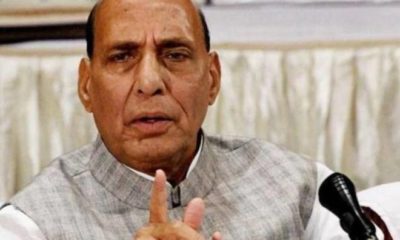World
Communication hotlines linking two Koreas blocked

Seoul : Seoul’s defence ministry has today confirmed that the all communication hotlines linked between South Korea and North Korea have been disconnected following the power cut of an inter-Korean factory park.
Defence Ministry spokesman Moon Sang-gyun said all communication hotlines linking the two sides have been blocked as Pyongyang cut off the lines on Thursday following the shutdown of the Kaesong Industrial Zone, as per reported.
Two military hotlines had been run between the two sides in the western and eastern regions, but the eastern hotline was already closed by a forest fire in 2013.
The telephone and fax lines in the western region were cut off from Thursday as Pyongyang shut down the joint factory park in its border city of Kaesong, Moon said.
Pyongyang’s decision came in the wake of Seoul’s announcement on Wednesday to completely stop operations at the joint industrial zone as part of punitive measures after North Korea’s Sunday launch of a long-range rocket and the fourth nuclear test on January 6.
Two communication channels for Red Cross officials and those in charge of inter-Korean affairs between the two sides were also closed at the truce village of Panmunjom, the spokesman said.
The communication hotline between South Korea’s second fleet command and North Korea’s west fleet command had already been closed off long ago, Moon said.
Concerns surged about possible military clashes between the two sides across the heavily armed border as all the communication channels that can help prevent military skirmishes disappeared all of a sudden.
Moon said the South Korean military was preparing for a possibility that North Korea may redeploy armed forces to the now emptied Kaesong factory park, noting that no special moves by Pyongyang forces around Kaesong have been detected yet.
Kaesong, Pyongyang’s third biggest city, is located just 10 km north of the inter-Korean land border and some 40 km north of South Korea’s capital Seoul.
World
Lockdowns in China Force Urban Communities to Defy Censorship and Vent Frustration Online

Shanghai’s rich middle class is leading a wave of online dissent over the strict and prolonged lockdowns imposed in various parts of the country. Chinese internet censorship is struggling as patience is wearing thin in many urban centers, coming up with creative forms of online protests.
Social Media Posts Revealing Lockdown Tension in Shanghai
Drawn-out lockdowns are nothing new in China as authorities insist with the nation’s zero-Covid policy since the start of the pandemic. Currently over This time around, however, metropolitan areas like Shanghai are increasingly difficult to keep quiet, given that its more than 25 million residents have seen weeks of total isolation along with food shortages and many other service interruptions.
Dozens of towns and reportedly over 300 million Chinese citizens have been affected by lockdowns of different severity. As expected, urban netizens have been most outspoken over their difficulties by finding creative ways to get around state censorship and bans placed on topics, news comments and spontaneous campaigns.
Shanghai residents have been using mobile proxies and hijacking seemingly unrelated hashtags to talk about healthcare issues, delivery failures and the overall severity of their situation. The “positive energy” that the Chinese government wants to transmit during the recent prolonged series of lockdowns does not come naturally to those counting food supplies and online censors are working hard to filter words, trending topics and undesired social media sharing.
WeChat groups and message threads are under constant monitoring. Posts questioning the zero-Covid approach have been quickly deleted, including by leading Chinese health experts like Dr. Zhong Nanshan. Video footage is soon censored and protests and investigations are quickly made to disappear.
Where this has not worked, officials have exposed banners with warnings and outright threats like “watch your own mouth or face punishment”, while drones have been patrolling the city skies. Yet, if anything, this has led to further tensions and unspoken confrontation with Shanghai’s educated and affluent middle class.
Creative Online Solutions Harnessing Civic Energy
Announcements by Chinese social media that they would be publishing the IP addresses of users who “spread rumors” have not helped either. Tech industry research has shown that much of Asia’s tech-savvy population has a habit of using mobile proxies and other privacy tools, quickly finding workarounds to browse the internet freely and talk to the world about the hottest topics.
The sheer volume of forbidden posts is already a challenge for the very censorship system, experts explain. Unable to track all trending hashtags, state workers overlook topics that speak about the US, Ukraine or other popular news. Linking human rights elsewhere to their situation, Chinese online dissidents establish their informal channels and “hijack” the conversation to share personal or publicly relevant information about the Covid suppression in their town.
Sarcastic and satirical posts still dominate. Others hope to evade the censors by replacing words from famous poems or the national anthem. One thing is certain – social media, when harnessed with the right creativity, has proven its ability to mount pressure on the government in even some of the most strictly controlled tech environments like China.





















